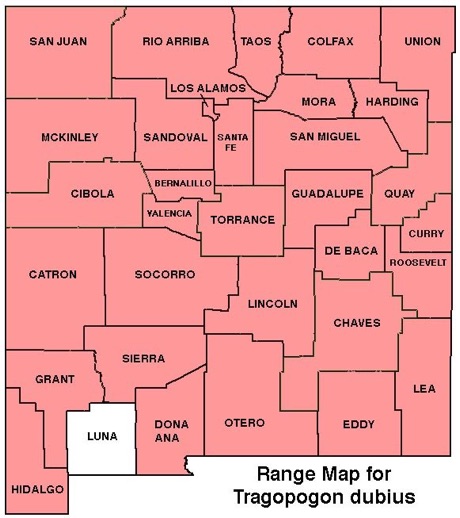WILDFLOWERS OF NEW MEXICO

This leafy alien with 15–31-inch tall, erect, branching stems is right at home throughout the Western U. S. Note the phyllaries are much longer than the yellow rays, and the 3–4-inch diameter (7.6–10 cm) puffball seed head is much larger than a Dandelion’s. Stems have a milky sap and a large taproot.
FLOWER: April–July. Each stem tip bears a showy, 1 1/2-inch wide (4 cm) flower head with a tight cluster of narrow, yellow petal-like ray flowers tipped with 5 tiny teeth. The 12 or more longer, outer rays surround smaller rays with showy dark stamens crowded in the center. No disk flowers are present. Distinctive, 2-inch long, narrow bracts (phyllaries) extend way beyond the rays. Flowers usually close by early afternoon, and buds are cone-shaped. The stems (peduncles) below the flower heads are hollow.
LEAVES: Alternate. Blades, 1–7-inches long, clasp the stem and taper to a long, thin point that is straight, not recurved or coiled.
HABITAT: Sandy, gravelly soils, meadows, roadsides, disturbed areas; shortgrass prairies, pinyon-pine, ponderosa forests.
ELEVATION: 5,000–9,800 feet.
RANGE: Naturalized and widespread west of Mississippi River and throughout North America.
SIMILAR SPECIES: Meadow Salsify, T. pratensis, throughout NM mountains, has ray flowers equal to the phyllaries and tapered leaves with recurved ends. The common yard invasive Dandelion, Taraxacum officinale, has a basal rosette with flowers on short stems.
NM COUNTIES: Nearly statewide (not reported in Luna Co.) in low- to mid-elevation habitats.

GOATSBEARD, YELLOW SALSIFY
TRAGOPOGON DUBIUS (TRAGOPOGON MAJOR)
Aster Family, Asteraceae
Perennial herb; introduced, naturalized


THE CONTENTS OF THIS WEBSITE ARE COPYRIGHTED AND CANNOT BE USED
WITHOUT PERMISSION OF GEORGE OXFORD MILLER
• All the florets are rays flowers (no disk flowers) (upper arrow).
• The phyllaries are much longer than the ray florets (lower arrow).




EMAIL ME